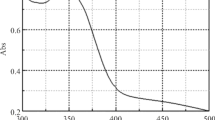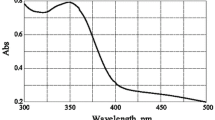Abstract
Formation constants for the calcium(II), copper(II), iron(II), magnesium(II), manganese(II) and zinc(II) complexes ofdl-NN'-dicarboxamidomethyl-NN'-dicarboxymethyl-1,2-diaminopropane (ICRF 198) and the 1,2-diamino-butane homologue (ICRF 226) have been measured potentiometrically at 37°C andI=150 mmol dm−3 [NaCl]. The constants are used in computer simulation models to assess the relative avidity of these compounds for biologically essential metal ionsin vivo. It is shown that the agents interact similarly with all of the ions studied except those of zinc(II), which are particularly strongly chelated by the hydrolysis product of ICRF 192.
This effect could be responsible for the difference in cytotoxicity exhibited by the antitumour agent ICRF 159 (Razoxane) and its inactive homologue ICRF 192. However, the mechanism through which this might occur remains unclear.
Similar content being viewed by others
References
A. Cole, P.M. May andD.R. Williams,Metal binding by pharmaceuticals, Part 1. Copper(II) and zinc(II) interactions following ethambutol administration, Agents and Actions11, 296–305 (1981).
A.M. Creighton, K. Hellmann andS. Whitecross,Antitumour activity in a series of bisdiketopiperazines, Nature222, 384–385 (1969).
K. Hellmann andK. Burrage,Control of metastases by ICRF 159, Nature224, 273–275 (1969).
A.J. Salsbury, K. Burrage andK. Hellmann,Inhibition of metastatic spread by ICRF 159: Selective deletion of a malignant characteristic, Br. Med. J.4, 344–346 (1970).
A.J. Salsbury, K. Burrage andK. Hellman,Histological analysis of the antimetastatic effect of (±)-1,2-bis(3,5-dioxopiperazin-1-yl) propane, Cancer Res.34, 843–849 (1974).
A.M. Creighton,3,5-Dioxopiperazine derivatives, U.K. Pat. No. 1234935 (1972).
M.T. Bakowski,ICRF 159, (±)1,2-di(3,5-Dioxopiperazin-1-yl) propane NSC-129 943, Razoxane, Cancer Treat. Rep.3, 95–107 (1976).
H.B.A. Sharpe, E.O. Field andK. Hellmann,Mode of action of the cytostatic agent ICRF 159, Nature226, 524–526 (1970).
A.M. Creighton andG.D. Birnie,Biochemical studies on growth inhibitory bisdioxopiperazines 1. Effect on DNA, RNA and protein synthesis in mouse-embryo fibroblasts, Int. J. Cancer.5, 47–54 (1970).
T.C. Stephens,An Investigation of the Effects of the Antitumour Agent ICRF 159 on the Growth of BHK-21 S Cells in Culture, PhD thesis, University of London 1974.
U. Witting, H.P. Bertram, E. Schumacher andG. Ritter,Der Einfluss der Bis-dioxopiperazine ICRF 159 und ICRF 154 auf die Cadmium-Ausscheidung im Urin bei Cadmium-Vergifteten Ratten, Int. Arch. Occup. Environ. Health42, 365–373 (1979).
U. Witting andE. Hultsch,Lead elimination by ICRF 158 in rats after chronic lead exposure, Int. Arch. Occup. Environ. Health48, 89–98 (1981).
D.D. Von Hoff, D. Howser, B.J. Lewis, J. Holcenberg, R.B. Weiss andR.C. Young,Phase I study of ICRF 187 using a daily for 3 days schedule, Cancer Treat. Rep.65, 249–252 (1981).
K.M. Dawson,Studies on the stability and cellular distribution of dioxopiperazines in cultured BHK-21S cells, Biochem. Pharmacol.24, 2249–2253 (1975).
A.I. Vogel,A Textbook of Quantitative Inorganic Analysis. Longman, London 1961.
D. Dyrssen, D. Jagner andF. Wengelin. InComputer Calculations of Ionic Equilibria and Titration Procedures, p. 204. Wiley, London 1968.
C.K. Prout, D.S. Sanderson andM.C. Couldwell,N,N-Methylethylene-bis(N-methylcarbamyl-glycinato) copper(II) dihydrate, Cryst. Struct. Commun.8, 181–188 (1979).
G. Berthon, P.M. May andD.R. Williams,Computer simulation of metal ion equilibria in biofluids. Part 2. Formation constants for zinc(II) citrate-cystinate binary and ternary complexes and improved models of low-molecular-weight zinc species in blood plasma, J. Chem. Soc. Dalton 1433–1438 (1978).
P.M. May, D.R. Williams, P.W. Linder andR.G. Torrington,The use of glass electrodes for the determination of formation constants. Part 1. A definitive method for calibration, Talanta,29, 249–256 (1982).
P.M. May, P.W. Linder andD.R. Williams,Computer simulation of metal-ion equilibria in biofluids: Models for the low-molecular-weight complex distribution of calcium(II), magnesium(II), manganese(II), iron(III), copper(II), zinc(II), and lead(II) ions in human blood plasma, J. Chem. Soc. Dalton 588–595 (1977).
P.M. May andD.R. Williams,Computer simulation of chelation therapy. Plasma mobilizing index as a replacement for effective stability constant, FEBS Lett.78, 134–138 (1977).
A.M. Creighton,Mechanism of action of ICRF 159, Proc. 12th Int. Cancer Congress, p. 83. Pergamon Press, Oxford 1978.
L.W. Oberley andG.R. Buettner,Role of superoxide dismutases in cancer, Cancer Res.39, 1141–1149 (1979).
N.G. Westman andS.L. Marklund,Copper-and zinc-containing superoxide dismutase and manganesecontaining superoxide dismutase in human tissues and human malignant tumours, Cancer Res.41, 2962–2966 (1981).
R.S. Kass andR.W. Tsien,Multiple effects of calcium antagonists on plateau currents in cardiac Purkinje fibers, J. Gen. Physiol.66, 169–192 (1975).
I.W. Taylor andN.M. Bleehen,Interaction of ICRF 159 with radiation, and its effect on sub-lethal and potentially lethal radiation damage in vitro, Br. J. Cancer36, 493–500 (1977).
R.J. Woodman, R.L. Cysyk, I. Kline, M. Gang andJ.M. Venditti,Enhancement of the effectiveness of daunorubicin (NSC-82151) or adriamycin (NSC-13127) against early mouse L1210 leukemia with ICRF 159 (NSC-129943), Cancer Chemother. Rep.59, 689–695 (1975).
N.R. Bachur, S.L. Gordon andM.V. Gee,The general mechanism of microsomal activation of quinone anticancer agents to free radicals, Cancer Res.38, 1745–1750 (1978).
E.H. Herman, R. Mhatre andD. Chadwick,Modification of some of the toxic effects of daunomycin (NSC-82151) by pretreatment with the antineoplastic agent ICRF 159 (NSC-129943), Toxicol. Appl. Pharmacol.27, 517–526 (1974).
E.H. Herman, V.J. Ferrans, W. Jordan andB. Ardalan,Reduction of chronic daunorubicin cardiotoxicity by ICRF 187 in rabbits, Res. Comm. Chem. Path. Pharmacol.31, 85–87 (1981).
C.E. Meyers, C.B. Simone, L. Gianni, R. Green, R.W. Klecker andM.F. Hendrickson,The role of doxorubicin-iron complex in superoxide production and membrane damage, Proc. Am. Assoc. Cancer Res.22, 28 (1981).
M. Gosálvez, M.F. Blanco, C. Vivero andF. Valles,Quelamycin, a new derivative of adriamycin with several possible therapeutic advantages, Eur. J. Cancer14, 1185–1190 (1978).
Author information
Authors and Affiliations
Additional information
Part 1 is Ref. [1].
Rights and permissions
About this article
Cite this article
Huang, ZX., May, P.M., Quinlan, K.M. et al. Metal binding by pharmaceuticals. part 2. interactions of Ca(II), Cu(II), Fe(II), Mg(II), Mn(II) and Zn(II) with the intracellular hydrolysis products of the antitumour agent ICRF 159 and its inactive homologue ICRF 192. Agents and Actions 12, 536–542 (1982). https://doi.org/10.1007/BF01965940
Received:
Issue Date:
DOI: https://doi.org/10.1007/BF01965940




